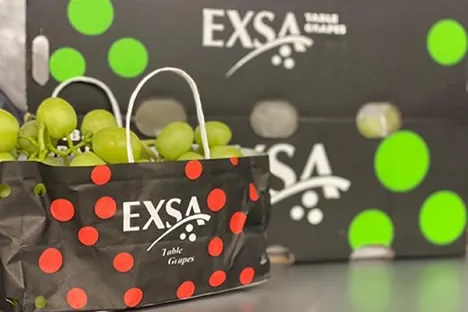Enough grapes have arrived in Europe to fill the shelves for Christmas, notes Eddy Kreukniet of Exsa Europe. "We're coming out of a long period of shortages, and last week, the supply was still scanty. But with the arrivals from Namibia and South Africa, the situation is easing quite quickly," he begins.
"However, the market is searching for a new price level. October and November were expensive, with high grape prices in the market and stores. Sales remained quite good, and due to the lower volume, the slightly lower consumption wasn't noticeable. The blueberry shortage means grape kept selling reasonably well, both in promotions and regular sales."
Eddy says the game is just about over for the rest of the year. "We have two more days before Christmas, and you effectively have three selling days next week. You thus lose roughly a week. But I'm quite optimistic about next year's sales. Retailers will be more willing to act, thanks to improved availability and lower prices. Also, there are limited alternatives," he explains.

"The Namibian and South African grapes are of good quality. The weather has been excellent in all growing regions lately. After the early growing regions, the intermediate areas in South Africa have also started, and grape harvesting begins in the Hex Valley next week. So, the game is fully on."
"The expected jump in volume from, particularly, the Orange River area lagged. The statistics show that 20-25% less volume was shipped than last year, while growth of about 10% was expected. But the disastrous volume decrease expected from Peru didn't materialize either. Brazil and Namibia have also sent significantly more fruit to Europe than last year. As a result, the market is statistically relatively similar to last year," says Eddy.
According to him, logistics remain a true gamble. "In the past weeks, we again had to wait five to seven days longer for boats than planned. The sector thinks it can solve this by using conventional ships. The first two have been loaded, and weekly departures are planned from weeks 1 to 8. I think that's an expensive answer, but not shipping fruit for a week costs even more, so those boats will undoubtedly be filled."
The Red Sea blockades are a current development. "The early production areas in India are about to start. Using the alternative routes, the fruit is at sea for seven days longer. Containers costing $1,000 more have also been mentioned. That creates a dilemma. Do you cut your losses or wait until the problems are solved?" Eddy wonders.
 For more information:
For more information:
Eddy Kreukniet
Exsa Europe
Tel: +31 (0) 887 350 003
Mob: +31 (0) 620 257 811
info@exsaeurope.com
www.exsaeurope.com
